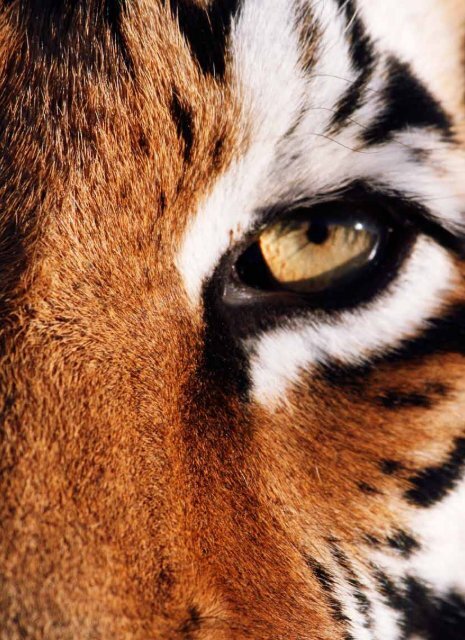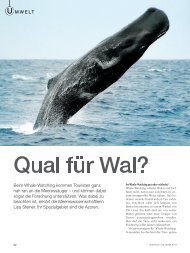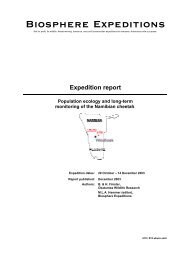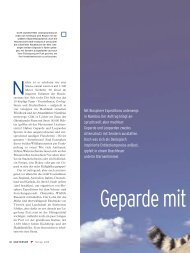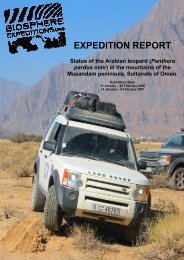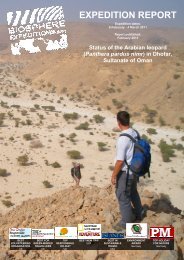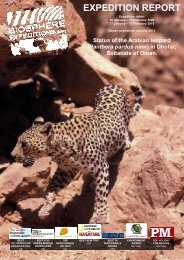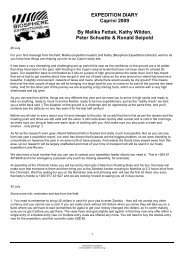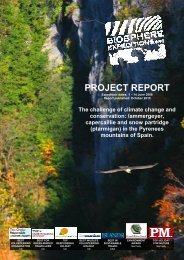View article 1.20 Mb - Biosphere Expeditions
View article 1.20 Mb - Biosphere Expeditions
View article 1.20 Mb - Biosphere Expeditions
You also want an ePaper? Increase the reach of your titles
YUMPU automatically turns print PDFs into web optimized ePapers that Google loves.
Wildlife<br />
WHERE<br />
THE<br />
WILD<br />
THINGS<br />
ARE<br />
Big cats are under threat. Right now, they’re<br />
also notorious. Denis Beckett recounts a<br />
personal encounter with John Varty’s tiger<br />
plus<br />
your guide to exceptional wild-cat<br />
encounters in sub-Saharan Africa
Wildlife<br />
WHERE<br />
TO FIND<br />
WILD CATS<br />
Everyone wants to see big cats<br />
on a game drive, but finding<br />
them in the vast landscapes<br />
of southern Africa is no picnic.<br />
Visiting key reserves is the best<br />
bet. Self-driving is possible<br />
in many national parks, but<br />
a private safari with experienced<br />
guides and trackers dramatically<br />
ups the chances of success.<br />
n my right hand, between thumb and forefinger, is<br />
a brown indentation. What it most looks like is a freckle. There are<br />
times it’s on public display, and people furrow their brows and say,<br />
‘Weird, hey, like stretch marks.’<br />
These times occur once or twice a year, when conversation turns<br />
to subjects like happy endings, or implausibility, or tigers. I display<br />
my freckle-dent, and wait for the stretch marks comment, and say,<br />
‘Do you want to know what it is?’<br />
Of course, the truthful answer would be no, as few sights are less<br />
dramatic than a freckle, with or without indentation. But people lie<br />
politely in that way we do, and say yes.<br />
Whereupon I say, ‘That is where I was bitten by…’ and I pause<br />
while they think, ‘That’s a bite? A mosquito’s, maybe.’ Then I resume:<br />
‘…a tiger.’<br />
Thought bubbles express doubt but someone (politely) asks<br />
where. I reply: ‘In the Karoo’, and smash any residual credibility to<br />
smithereens. Which is funny, because it’s all true.<br />
When the 2000s were infant, man-of-the-wild John Varty was on<br />
a mission. Tigers were dying out in India; he would found an African<br />
line, recreating tigers here where, his research informed him, they<br />
had lived in Gondwanaland days.<br />
Of course, half the world immediately shrieked that John is out<br />
of line; he can’t do such things. My first instinct was exactly that:<br />
tigers don’t belong here, tigers aren’t ours, tigers are India’s, along with<br />
a bit of China and other places very, very far from the Karoo.<br />
But why do we think that, exactly? We eat pizza, right, and vindaloo<br />
and chow mein? Never saw no one holding up a No Entry notice<br />
over foreign food. And look at ostriches. They were ours, once,<br />
when it was their feathers that made fortunes, long before anyone<br />
thought of eating them. Now? Argentina, I’m told, leads the<br />
revolution, installing ostrich fillet as the world’s healthiest meat,<br />
and they aren’t importing it from the Little Karoo, which in the<br />
meantime does all it can to punt itself as the home of port, putting its<br />
fingers in its ears to outraged complaints from Portugal.<br />
To me, John’s reshuffling of the wild is an admirable venture.<br />
Strength to his arm. I confess that when I contemplate an Indian<br />
entrepreneur setting out to stock Rajasthan with lions, co-opting<br />
our proudest piece of branding and the economic potential attached<br />
to it, violent thoughts enter the mind. But hey, people, this world<br />
is shrinking. If John’s usurping wakes up Asian conservation, he’s<br />
done everyone a favour.<br />
LEOPARDs<br />
In South Africa, hit the Sabi Sand<br />
Reserve, which adjoins the<br />
Kruger Park, for one of the densest<br />
concentrations of these elusive<br />
cats on the planet. At MalaMala, an<br />
average of four a day were spotted<br />
in 2008, and they’re as habituated<br />
to visitors as wild leopards can be.<br />
malamala.com<br />
In the Madikwe Reserve, close<br />
to the Botswana border, sightings<br />
cannot be guaranteed – even<br />
with Morukuru Lodge’s Shangaan<br />
trackers on your side. But should<br />
a kill be spotted and conditions<br />
right, a ranger may be persuaded to<br />
set up a camera trap for exceptional<br />
pictures. morukuru.com<br />
In Zambia, South Luangwa<br />
National Park’s ox-bow lagoons<br />
are home to vast quantities of<br />
game – and leopards. Self-driving<br />
is possible, but Norman Carr Safaris<br />
bush camps offer better chances of<br />
success. At Kakuli Camp guests can<br />
track the predators on foot. ‘There<br />
can be nothing more exciting than<br />
respectfully and unobtrusively<br />
tracking a leopard,’ says director<br />
Christina Carr, ‘maybe seeing her<br />
at “prey’s-eye view”, perhaps even<br />
getting a waft of that unmistakeable<br />
“cooking rice” scent of leopard, then<br />
creeping away without alarming<br />
her.’ normancarrsafaris.com<br />
(continued on page 49)<br />
46 high life south africa
Now you see me<br />
As masters of camouflage, leopards are<br />
harder to spot. Their numbers in the wild<br />
are therefore greater than that of lions and<br />
cheetahs combined. The leopard is still,<br />
however, a ‘near threatened’ species<br />
on the IUCN Red List<br />
There can be nothing more exciting<br />
than getting a waft of the unmistakeable<br />
‘cooking rice’ scent of leopard
Wildlife<br />
Cool cat club<br />
(this page) Until 10,000 years ago,<br />
the lion was the most widespread<br />
land mammal on the planet after<br />
humans. They were found throughout<br />
Africa, Asia, Europe and the Americas;<br />
(opposite) There are around 12,500<br />
cheetahs left in the wild in Africa,<br />
with the most in Namibia. They<br />
have been extinct in India for 100<br />
years, and there has been talk of<br />
reintroducing them there<br />
the numbers of the king of<br />
cats have plunged to a maximum<br />
of 40,000 in the wild<br />
48 high life south africa
South Africa<br />
(continued from page 46)<br />
LIONs<br />
The numbers of the king of cats have<br />
plunged to a maximum of 40,000 in the<br />
wild. For the black-maned variety, target<br />
the Kgalagadi Transfrontier Park.<br />
Early morning walks (no under-12s) and<br />
night drives can be booked from Twee<br />
Rivieren, Nossob, Mata-Mata and the<br />
Kalahari Tented Camp. sanparks.org<br />
For unusual behaviour, the Savuti area<br />
in Chobe National Park, Botswana, is<br />
the place to go. Here<br />
a family of lions began to prey on young<br />
elephants during a drought. Now<br />
numbering more than 30, the pride has<br />
learnt to dispatch adults,<br />
and at one point elephant made up half<br />
its diet. In Hwange National Park in<br />
Zimbabwe (zimparks.org), elephanthunting<br />
lions have also been spotted,<br />
and the famous lions of Moremi, in<br />
Botswana’s Okavango Delta, have<br />
dispatched youngsters.<br />
For tree-climbing lions (all the better<br />
to photograph), Lake Manyara in<br />
Tanzania is most famous (and there’s the<br />
chance to stay in &Beyond’s Tree Lodge).<br />
andbeyondafrica.com<br />
Closer to home, they’ve been spotted<br />
in trees in both the Kruger Park and<br />
Hluhluwe-Umfolozi in KwaZulu-<br />
Natal, spotted on the reserve’s famous<br />
wilderness trails. kznwildlife.com<br />
cheetahs<br />
The best bets to see these rare,<br />
exceptional felines include the Masai<br />
Mara in Kenya and Etosha in Namibia<br />
(etoshanationalpark.co.za) – and<br />
sometimes the Kruger.<br />
Now, after 125 years, they can also be<br />
found in the Karoo: the amazing Sibella,<br />
rescued and relocated to Samara some<br />
years ago, has raised 18 kittens – two<br />
per cent of the wild cheetah population<br />
in South Africa! The reserve has just<br />
welcomed a new breeding female,<br />
Bellini. The odds of seeing them in<br />
action are better than most, and you<br />
can track them on foot. samara.co.za<br />
SERVALs<br />
Rangers will shake their heads if asked<br />
to pull this big-eared cat out of the<br />
bag. The trusty Kruger – especially the<br />
grassy plains north of Lower Sabie –<br />
is said to be a good bet. sanparks.org<br />
Those in the know say the very<br />
best spot is Ngorongoro Crater in<br />
Tanzania, particularly in the tall grasses<br />
of the eastern section of the crater floor<br />
(lions and cheetahs are also commonly<br />
sighted). ngorongorocrater.org<br />
John’s idea might have elicited scepticism, not to say screaming<br />
denunciation, but these were not things to distract a man with<br />
a plan. His farm on the Orange River received its first two tigers<br />
from a Canadian zoo, healthy youngsters of around 200 kilograms<br />
each, bearing the exotic tigerish names of Ron and Julie.<br />
Walking to the river for his morning swim with the tigers, John<br />
showed me 89 stitches in his thigh, from a day that Julie was having<br />
such fun on bathtime games that she forgot to retract her claws.<br />
As we walked, Julie gambolled; a kitten with elephantiasis. Ron<br />
ambled calmly beside me making a purr-like sound from his innards.<br />
That meant friendship, John said.<br />
Then suddenly, eyebogglingly, my hand was in Ron’s mouth.<br />
My thumb and its thigh were tightly clamped. This showed more<br />
friendship, said John; it’d be just a moment.<br />
That was consoling, but I couldn’t help wondering why John’s<br />
voice rose an octave. Just-a-moment stretched. It stretched some<br />
more. I developed an awareness that if Ron hiccupped I’d be his<br />
nine-fingered friend.<br />
John eyeballed Ron and whacked his nose with a little discipline<br />
baton, saying ‘bad tiger!’ in the tone you say ‘bad dog!’ when your<br />
spaniel digs up the dahlias. Ron’s mouth stayed clamped. John<br />
whacked again. I hoped that nose whacks did not induce hiccups.<br />
It was like stalemate, except that my pain meter was rising<br />
and so was John’s sweat meter. Then, abruptly as it started, Ron<br />
opened his mouth and resumed his amble, and it was all over except<br />
for two startling dents in my hand, neither drawing blood.<br />
John and Ron and the sound ‘bad tiger!’ will live long in my<br />
mind. And if, one day, John’s vision is fulfilled, at least the Karoo<br />
part of the story will sound believable.<br />
high life south africa<br />
49
CLOSER<br />
ENCOUNTERS<br />
TRACK CHEETAHs<br />
Private reserves like Samara (see<br />
previous page) have offered this<br />
activity to guests for some time,<br />
but now the Mountain Zebra<br />
National Park in the Eastern Cape<br />
gives budget visitors the chance<br />
to find the reserve’s six cheetahs.<br />
A ranger will use antennae to locate<br />
the spotted beasts, who all have<br />
radio collars. Once in range, guests<br />
can approach closer on foot –<br />
a heart-in-mouth feeling until the<br />
cat comes into view. There are no<br />
lions here, so cheetahs are the top<br />
predators. It costs R250pp; book via<br />
+27 (0) 48 881 2427.<br />
SMALL IS BEAUTIFUL<br />
&Beyond’s Phinda Private<br />
Reserve in KwaZulu-Natal, known<br />
for its cheetahs and leopard<br />
research, offers a tip-top big five<br />
experience. But for R625pp, the<br />
lodge arranges private visits for<br />
its guests to Emdoneni, a local<br />
breeding centre for the smaller of<br />
SA’s endangered wild cats: servals,<br />
African wild cats, caracals and<br />
cheetahs. ‘Even as a South African<br />
working on a reserve, you don’t<br />
get to see caracal – here you can<br />
see them from 30cm away, tufty<br />
ears and all,’ says Phinda’s Celeste<br />
Vorster. Guests walk through<br />
enclosures, but this is not a petting<br />
zoo. The exception are a few<br />
cheetah ‘ambassadors’, who can<br />
be approached and who ‘purr like<br />
steam engines’ when scratched<br />
behind the ears. This is a breeding<br />
centre, and the intention is for<br />
young to be released into the<br />
wild where possible, according to<br />
Vorster. phinda.com<br />
rescued cats<br />
Shamwari in the Eastern Cape<br />
has some expansive enclosures for<br />
a number of big cats who had fallen<br />
on hard times. The rescued animals<br />
of the Born Free Foundation (freed<br />
from circuses, zoos and sometimes<br />
private homes) have space to live<br />
out their lives in sunshine with good<br />
care. Visitors have the chance to<br />
observe them in their enclosures<br />
– a poignant comparison with the<br />
wild cats that can be seen on the<br />
reserve. shamwari.com<br />
WALK WITH LIONS<br />
Stroll through the African bush,<br />
dust in the nostrils and a couple of<br />
young lions padding alongside –<br />
no leashes. Lion Encounter works<br />
to rehabilitate captive-bred lions<br />
(find out more at lionalert.org).<br />
Guests can accompany the cats<br />
on their daily walks as they begin<br />
to hone their hunting skills. The<br />
walks take place near Victoria Falls<br />
in Zimbabwe ($130/around R1,100),<br />
and near Livingstone, Zambia ($140/<br />
around R1,200). lionencounter.com<br />
soft touches<br />
At the Cheetah Outreach Centre<br />
at Spier in the Cape winelands, the<br />
captive-born cats can be petted<br />
(mood swings allowing) for R110.<br />
Some funds raised pay for Anatolian<br />
shepherd dogs to be placed on<br />
farms. The dogs prevent predation,<br />
which stops farmers from hunting<br />
the big cats. cheetah.co.za<br />
The granddaddy of cheetah<br />
breeding centres is De Wildt, in<br />
the Magaliesberg in Gauteng,<br />
now renamed the Ann van Dyk<br />
Cheetah Centre. For R380, visitors<br />
can see cheetahs run at top speed<br />
(120 km/h) as part of a three-hour<br />
tour. It costs R180 extra to actually<br />
stroke a cat. dewildt.co.za<br />
Tenikwa, near Plettenberg Bay,<br />
is a place to see the cats that evade<br />
game-drive sightings: slinky servals,<br />
pint-sized black-footed cats, African<br />
wild cats and caracals. They are<br />
housed in enclosures, which guests<br />
stroll through – handler present<br />
– for R160; no touching allowed.<br />
One can also join cheetahs on their<br />
morning or evening walk through<br />
the forest. As a staff member put<br />
it, ‘The cheetahs really walk you.’<br />
R500pp, adults only. tenikwa.com<br />
Note: Many places offer the chance<br />
to pet cute cubs, but find out what<br />
happens to them when they grow up<br />
– rehabilitation is difficult and costly,<br />
and some may end up in canned<br />
hunts. According to the NSPCA,<br />
allowing people to handle wild<br />
animals sends the ‘incorrect message<br />
that they exist for our entertainment.<br />
We urge the public to consider<br />
the long-term implications for the<br />
animal… Predators are naturally<br />
dangerous, and hand-reared<br />
animals lose their fear of humans. It is<br />
astonishing that people are surprised<br />
when tourists are attacked.’<br />
From top<br />
Caracals, along with African wild cats,<br />
servals and black-foooted cats, are<br />
among the most elusive of the felines;<br />
volunteers help tag and monitor<br />
cheetahs in Namibia, which is leading<br />
the way in conservation<br />
50 high life south africa
Wildlife<br />
Text: Janine Stephen. Photographs: Gallo/Getty Images; supplied<br />
Ire of the tiger<br />
Recently, there’ve been some big-cat attacks. A cheetah<br />
attacked a tourist, and John Varty was seriously injured by<br />
one of his tigers. He remains undeterred. This is his story…<br />
If you’re a visitor to Africa there are certain places which are<br />
prime areas to view big cats – for example, you’ll find leopards at<br />
Londolozi, cheetahs in the Masai Mara in Kenya. There are big<br />
prides of lions in the Serengeti, as well as the Kalahari, and again at<br />
Londolozi, Singita and the Kruger Park, although that’s more limited<br />
because you can’t go off the road.<br />
In terms of Tiger Canyons and tigers, this is an experiment.<br />
It’s not a Big Five reserve. We started this project because the<br />
wild tiger is declining. When I started it in 2000, there were reputed<br />
to be 5,000 tigers in the wild. Today that number is close to 1,000<br />
and still rapidly declining. This is due to the massive number of<br />
people encroaching on their space. A tiger in India competes with<br />
320 people per square kilometre. The problem also lies with apathetic<br />
governments, corruption and poaching.<br />
What we’re doing is an ex-situ conservation project. We’re trying<br />
to save the tiger away from where it’s at threat. We have people<br />
visiting Tiger Canyons simply because they can’t get decent pictures<br />
of tigers in the wild.<br />
My situation was a freak accident. This tiger was brought up in the<br />
wild and had lost his territory due to a flood, so I had to put him in<br />
our aim is to<br />
create wild<br />
populations of<br />
tigers, so people<br />
can come to view<br />
them here, just<br />
like they do lions<br />
or leopards<br />
a temporary boma, out of his natural territory. As I closed the gate<br />
to the boma, I saw a tiger up on a rock about 120 metres away from<br />
me. I thought it was him. In fact, the male was lying only about 10<br />
or 20 metres away. As I turned my back he put his paw through the<br />
gate and pulled me back.<br />
In the case of the cheetah attack [in Kragga Kamma Game Park in<br />
the Eastern Cape], the people made a fundamental mistake – they<br />
took children into the enclosure. It’s a big cat’s instinct to attack<br />
anything smaller and weaker than it.<br />
I’m not a fan of captive animals and petting parks; it’s against our<br />
principles. I don’t believe in incarcerating animals for people to look<br />
at. Our aim is to create wild populations of tigers, so that people can<br />
come to view them here, just like they do a lion or a leopard. This<br />
can create tourism, and the jobs that come with tourism. That’s how<br />
we can save the tiger.<br />
Tiger Canyons is in the Free State and is open for visits. jvbigcats.co.za<br />
way to go<br />
volunteering<br />
• <strong>Biosphere</strong> <strong>Expeditions</strong> offers 14-day working holidays in<br />
the Khomas Hochland of central Namibia; participants set<br />
up cameras and cage traps to catch leopards, caracals and<br />
cheetahs, track collared animals and collect data. Leopards<br />
are the main focus and their interactions with prey and other<br />
predators are carefully documented. Plus there’s a chance<br />
you’ll encounter black-footed or African wild cats. It costs<br />
£1,690/about R22,300; expeditions run from July to October.<br />
biosphere-expeditions.org<br />
• Wildlife ACT gets you behind the scenes in four reserves in<br />
KwaZulu-Natal. Supported by the WWF and Ezemvelo KZN<br />
Wildlife, volunteers help survey lion and cheetah populations<br />
by collaring, following individuals and collecting data. ‘We<br />
work in very small teams of four, and are the only volunteer<br />
opportunity in provincial parks. You’re contributing to key<br />
conservation work,’ says Wildlife ACT’s Dr Simon Morgan. It<br />
costs R10,750 for two weeks, and R8,400 for every subsequent<br />
two-week period. wildlifeact.com<br />
TAKE OFF<br />
British Airways flies to Johannesburg from London. From<br />
Jo’burg it has flights to Windhoek, Namibia, and Livingstone,<br />
Zambia, as well as within South Africa to Cape Town, Durban<br />
and Port Elizabeth. Visit ba.com.<br />
high life south africa<br />
51


